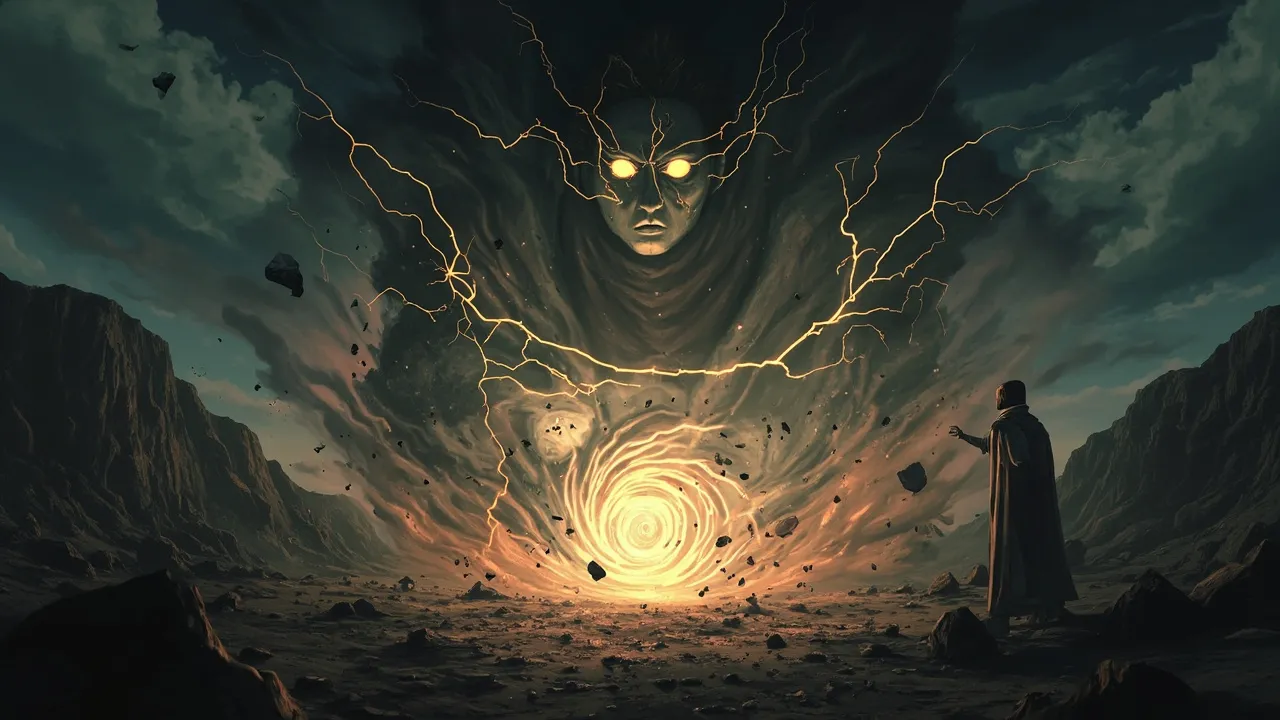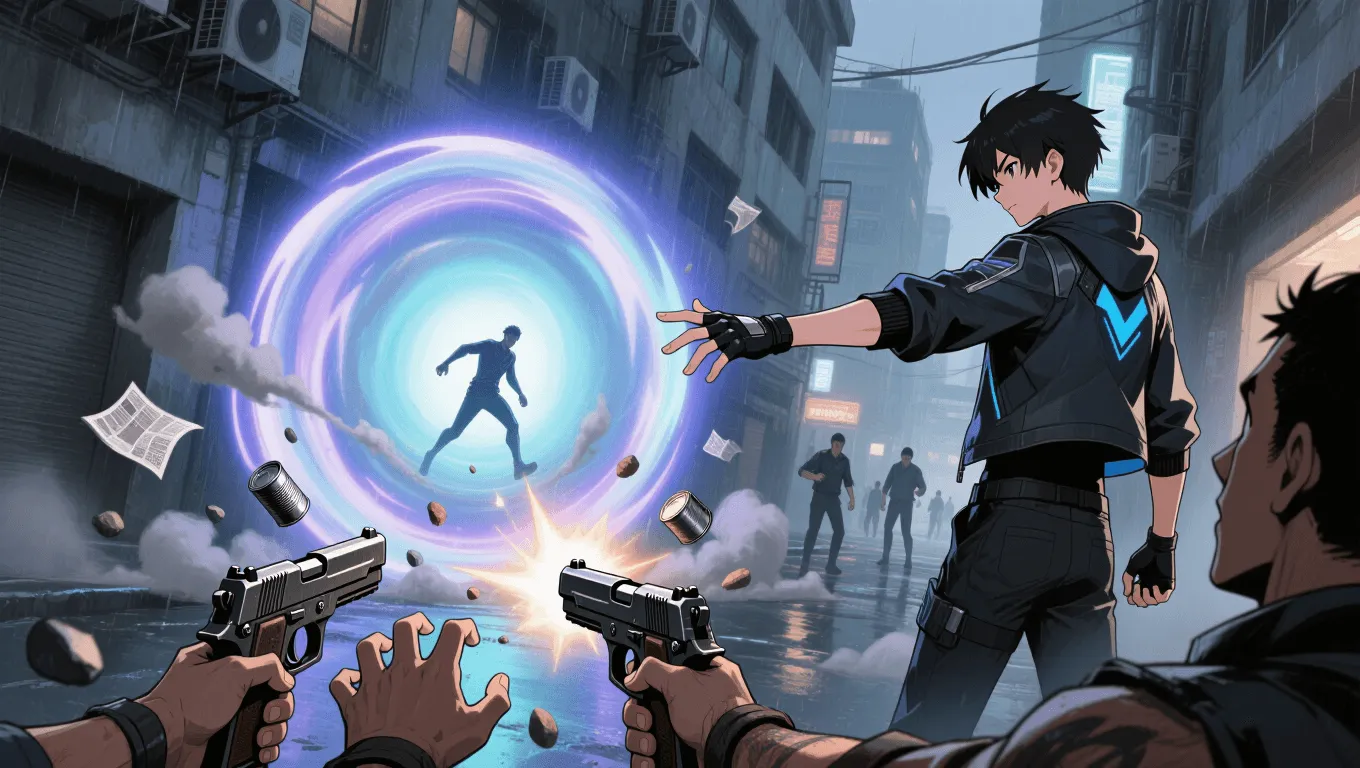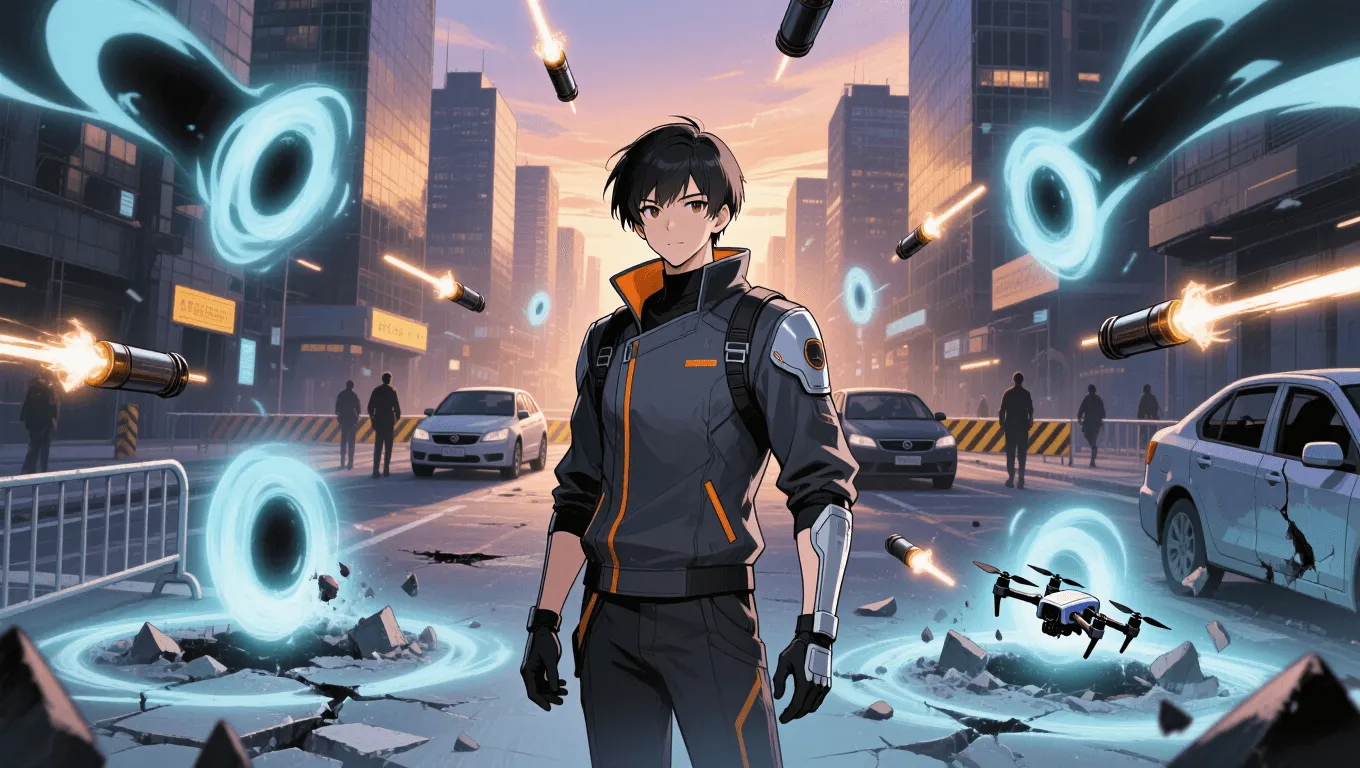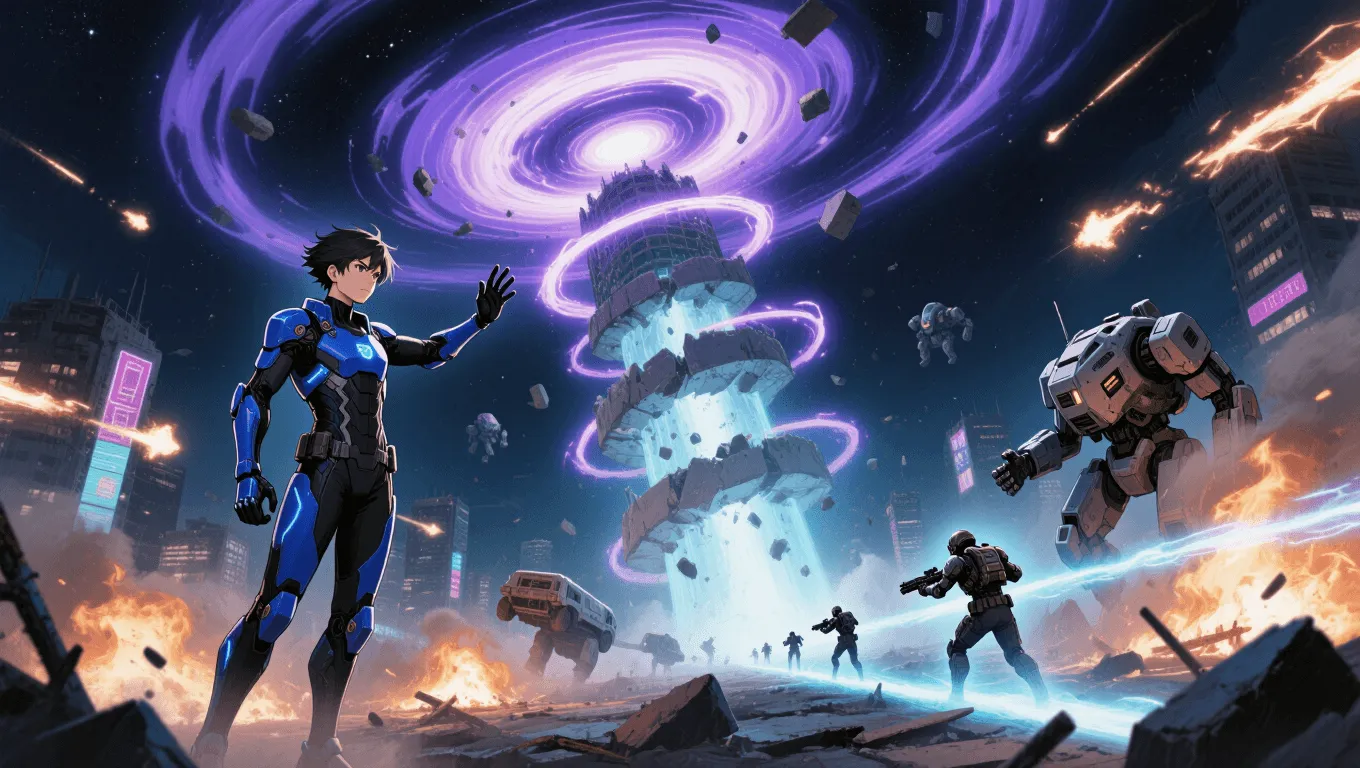Gravity Well

Gravity Well Video Demo 🎬
Table of Contents
What Is Gravity Well
The gravity well superpower lets a user create and control concentrated gravitational fields that tug everything toward a chosen center. Mentioned variously as gravity manipulation, singularity casting, or micro–black hole projection, gravity well focuses on a localized “pit” of force rather than broad mass manipulation. Within its radius, objects gain weight, trajectories bend, and motion compresses, turning open terrain into a trap that favors the user’s positioning and timing.
Unlike passive heavy-gravity zones, a gravity well is dynamic: its center can be placed midair, anchored to terrain, or even stitched to a moving target. The user tunes g-force, duration, and radius to immobilize foes, deflect projectiles, bunch enemies for area-of-effect attacks, or shape movement paths. For a broader look at related abilities, browse the superpower wiki, or spark ideas with the random superpower generator.
Core Abilities of Gravity Well
Focused gravitational sink
The signature move generates a local event-like horizon that accelerates bodies inward. Anything crossing the boundary experiences amplified weight and reduced freedom of movement, making the center a natural capture point.
Adjustable intensity and radius
Skilled wielders scale from subtle pressure (crowd control, takedowns) to crushing force that buckles armor and fractures stone. Precision micro-wells pluck gadgets from hands; wide fields pin squads or redirect drones.
Vector steering
The user can tilt the pull so it’s not purely down. Sideways or diagonal vectors yank targets off balance, curve bullets, and sweep debris into controlled piles—useful for line-breaking or funneling opponents into kill zones.
Momentum capture and redirection
Projectiles spiral inward; thrown weapons lose line; explosive devices cluster for safer detonation away from allies. With finesse, debris can be parked in orbit, forming a rotating shield before being collapsed as shrapnel.
Motion-time compression
Inside the field, acceleration ramps quickly. Short, high-g spikes convert small drops into heavy impacts, enabling slam finishes without tall structures or long falls.
Environmental shaping
Floors crater, walls bow, liquids funnel, fog streaks inward—revealing hidden positions. In low- or zero-gravity environments, a gravity well acts as an anchor or navigation node.
Application / Tactical Advantages in Combat
Area denial and zoning
Placing a well across a doorway, bridge, or corridor creates an instant choke. Enemies slow, stumble, and clump, making them prime for AoE attacks and coordinated takedowns.
Anti-projectile umbrella
Aerial wells intercept arrows, shells, and shrapnel, bending trajectories into safer arcs or collecting them for controlled detonation. This makes an excellent forward screen for advancing teams.
Grapple breaker and crowd control
Heavy melee fighters rely on stance and momentum. A sudden sink multiplies their mass, collapsing footwork. In multi-target situations, staggered wells impose repeated knockdowns and ragdolls.
Pathing and mobility plays
By steering the vector, the user can slingshot self or allies between covers, reel up vertical shafts, or subtly bias enemy movement into crossfire—stealth repositioning without visible wires or platforms.
Non-lethal capture
Lower settings immobilize with minimal damage, making gravity well ideal for arrests, hostage recovery, or when collateral must be minimized.
Finisher setups
Wells bunch foes for cone attacks, stun grids, or precision bombardment. A coordinated team can stack snares, silence effects, and burst damage right as the cluster reaches maximum density.
Level: Level 1 🏙️, Level 2 🌇, Level 3 🌃
Level 1 🏙️ Street-Tier Controller
Beginners create brief, person-sized wells at short range. Effects include forced stumble, weapon yank, and short-range projectile drift. The field lasts seconds, with noticeable cooldowns and a risk of friendly pull in tight rooms. Environmental impact is cosmetic—dust, loose paper, rolling debris moving inward.

Typical plays: break a charge, catch a tossed grenade, disarm a single opponent, stall a getaway vehicle long enough for allies to act.
Level 2 🌇 City-Tier Specialist
Intermediate users sustain multiple wells, shape vectors, and extend range to city-block scales. They can deflect rifle fire measurably, down small drones, and disrupt light vehicles. Structural impact becomes real—cracked pavement, buckled railings, dented hulls. Overlapping fields produce corridors, traps, and “gravitational herding.”

Typical plays: create an anti-artillery pocket, maintain a rotating debris shield, run capture funnels that spit enemies into stun nets, or break formations during urban operations.
Level 3 🌃 Night-Tier Apex
At the apex, wells approach micro-singularity behavior without catastrophic runaway. The user spikes g-loads to bone-crushing levels, shears armor, curves energy bolts, and “pins” a well to moving targets like a personal horizon. Chain-casting can rewrite a battlefield—collapsing towers in controlled patterns or establishing gravity corridors that slingshot allies and swallow barrages.

Typical plays: anti-air snares, city-scale zone control, precision demolitions, and last-stand bulwarks where incoming fire is curved into inert piles.
Limitations of Using the Gravity Well
-
Metabolic and cognitive strain: High-g fields are taxing. Long durations cause migraines, vertigo, tremors, and blackout risk. Responsible users favor short, surgical bursts with disciplined breathing and pacing.
-
Line-of-sight and medium sensitivity: Dense materials, interference fields, or turbulent media (deep water, sandstorms) distort shaping. Underwater, cavitation and wake effects can destabilize the node or mask its edges.
-
Collateral damage: Even moderate wells stress structures. Floors collapse; vehicles fishtail; bystanders risk sprains or joint compression. Strict coordination and clear callouts are needed to avoid dragging allies.
-
Diminishing returns versus extreme mass: Anchored tanks, megafauna, or fortress plating resist displacement. Chained wells, longer durations, or synergy with other powers may be required to move or immobilize such targets.
-
Heat and vibration buildup: Amplifiers and stabilizers can overheat. Prolonged use introduces micro-vibrations that give away position or compromise delicate equipment.
Weakness Against What Other Superpowers
-
Inertial dampening and mass anchoring: Abilities that sever acceleration coupling or lock mass to substrates drastically reduce the well’s pull, letting targets wade through with partial immunity.
-
Force fields and spatial partitions: Hard light, telekinetic shells, or spatial “rooms” decouple targets from external fields, attenuating or nullifying the inward tug.
-
Intangibility and phase shift: Phased targets don’t couple normally to gravitational force and slip through the center without harm.
-
Velocity control and temporal dilation: Speedsters and time dilators step outside the vulnerable window, escaping before g-load ramps or resetting their approach with clean vectors.
-
Resonance and vibration control: Counter-oscillation can scramble a well’s coherence, scattering it into harmless ripples or shifting the center off target.
Synergistic Power Combos
Telekinesis and magnetism
- Telekinesis corrals nonferrous debris while magnetism selects for armor and weapons. Together with a gravity well, this creates layered control—pin, strip, and pummel.
Elemental manipulation
- Air users stack cyclones over the well for suffocation and disorientation. Water users create crushing vortices. Earth users raise berms that funnel waves of enemies into the sink.
Sonic and vibration
- A clustered group is perfect for sonic shock cones. Conversely, precising vibrations in walls plus a timed well yields surgical demolitions with minimal collateral.
Portal and spatial folding
- Portals at the well’s edge drain ordnance—or entire squads—into safe containment spaces. Closing the loop prevents escape while the well “feeds” the doorway.
Illusion and stealth
- Hiding field boundaries tricks foes into overcommitting. A stealth operative baits pursuit straight into the trap, signaling the collapse for maximum effect.
Known Users
Gravity-themed characters appear frequently in comics and games. A leading example is Graviton from Marvel Comics, a longtime antagonist who manipulates gravitational forces on a massive scale and has repeatedly showcased singularity-like pulls, anti-projectile fields, and battlefield crushing effects. Read more at the official profile: Graviton (Marvel). Other franchises feature tacticians, mech pilots with event-horizon projectors, and spacefaring commanders who use localized gravitational fields for station defense and ship interdiction.
Teams often pair a gravity specialist with marksmen, telekinetics, or elemental controllers to exploit clustering, line breaking, and controlled detonations—the hallmark moves that make this power decisive.
Explore More Powers
Keep building a roster of counters, combos, and creative options by browsing the superpower wiki. Or, if inspiration strikes best by chance, try a spin with the random superpower generator.
